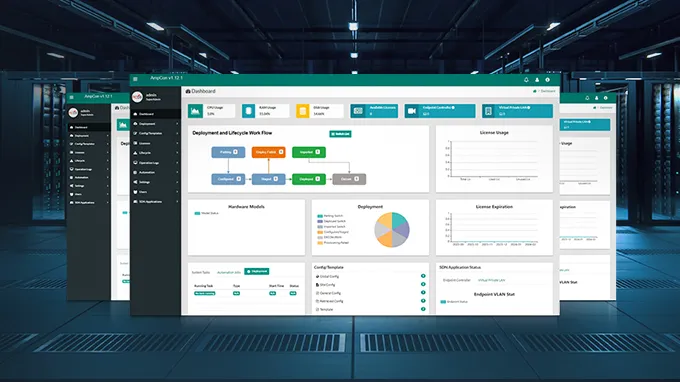5 Basic Port Types of WDM Mux and Demux: What You Need to Know
Fiber Mux Demux is a main device to build a higher-capacity C/DWDM network. Both CWDM and DWDM Mux and Demux come with various types of ports, each playing an indispensable role in building WDM networks. How much do you know about the Mux ports on the C/DWDM Mux Demux, such as line port, monitor port, expansion port, etc? Are you familiar with the applications of these different ports? Get the details about the mux port explanation in the following text for better use of mux and demux.
Before delving into the main content, you may watch the video below, which might assist you in better comprehending the textual information.
Must-Have Ports on WDM Mux and Demux
As we know, the basic function of the C/DWDM Mux Demux is combining data rates of different wavelengths over the same fiber cable to increase the network capacity. Thus, the must-have ports on C/DWDM Mux should include line ports used to connect the outside fibers with the fiber Mux Demux and channel ports for multiplexing and demultiplexing different wavelengths.
Line Port
Line port is one of the important ports for each WDM multiplexing and demultiplexing. There are two types of line ports: dual-fiber and single-fiber. As for single-fiber WDM Mux Demux, it requires only a simplex fiber patch cable to transmit the signals, whereas for dual-fiber WDM Mux Demux, duplex fiber patch cable is needed for transmission. This gives rise to three different transmission configurations: single-fiber unidirectional, single-fiber bidirectional, and dual-fiber bidirectional.

Figure1. Single-fiber Line Port VS Dual-fiber Line Port
Single-fiber unidirectional means that optical modules are connected through only one optical fiber, and signals can only be sent from the transmitter to the receiver, not in reverse. The advantage of this transmission is that the system is relatively easier to design and more convenient for separate wavelength monitoring.

Figure2. Single-fiber Unidirectional Transmission
Single-fiber bi-directional is used to transmit and receive optical signals in two directions at the same time in an optical fiber, just like the positive and negative lanes separated by the separation belt on the road. Vehicles on both sides of the road run in their own lanes without interfering with each other. The advantages are also obvious. Single-fiber bidirectional technology can use only one fiber to complete the work that two fibers can do, the existing fiber transmission capacity has been doubled, thus greatly saving fiber resources.

Figure3. Single-fiber Bidirectional Transmission
Dual-fiber bidirectional, as the name suggests, means that the Dual-fiber DWDM multiplexer/demultiplexer uses two optical fibers for signal transmission. One fiber transmits optical signals in one direction, while the other transmits optical signals in the opposite direction. The advantage of dual-fiber DWDM Mux/Demux is that it utilizes two separate optical fibers for transmission. Each signal is carried by a different wavelength and will not interfere with each other, resulting in higher reliability.

Figure4. Dual-fiber Bidirectional Transmission
Channel Port
Channel port is another must-have port responsible for connecting to the optical module of the corresponding band for sending and receiving signals. For example, CWDM technology has 18 wavelengths ranging from 1270nm to 1610nm with a channel space of 20nm. The channel Mux port counts on CWDM Mux and Demux typically ranges from 2 to 18 channels. In contrast, DWDM technology adopts the wavelength ranging from 1470nm to 1625nm, usually with channel space of 0.8 nm (100 GHz) or 0.4 nm (50 GHz). Consequently, DWDM Mux Demux can support a more extensive range of wavelengths, with the channel port count typically ranging from 4 to 96. This allows for the multiplexing of more signals, achieving a much higher capacity.
Functional Ports on WDM Mux and Demux
In addition to the essential line port and channel port mentioned above, Mux and Demux can incorporate/customize additional special Mux ports for better construction of WDM networks. The following will introduce these special ports that are often added to C/DWDM Mux Demux.
Expansion Port
The expansion port on the WDM Mux and Demux is designed to add more wavelengths or channels to an existing network. As shown in the diagram below, if you have a 4 channels DWDM Mux Demux with wavelengths from C20 to C23 and you wish to add more wavelengths to increase network capacity, you can achieve this through the expansion port. Connect the expansion port of the 4ch DWDM Mux Demux to the line port of another 8ch DWDM Mux Demux. This introduces new DWDM wavelengths, thereby adding communication channels to the existing network. By using the expansion port, you can easily increase the overall capacity of the WDM network to accommodate the growing communication demands without the need to replace the entire equipment.

Figure5. Feature of Expansion Port
Monitor Port
The monitoring port of the WDM Mux and Demux can provide flexible monitoring at a split of 1% (2%, 3%, 5% optional). This allows testing of optical signal power, wavelength, and OSNR without interrupting services. If you choose a single-fiber mux and demux, the monitor port should be a single fiber optic port. For dual-fiber WDM Mux Demux, you can add a duplex monitor port for the whole network monitoring, or just add a simplex port for Mux or Demux monitoring. Here shows a typical point-to-point network with the use of 40CH DWDM Mux Demux where two switches are connected over DWDM C51 wavelength and an optical power meter is used to monitor the power on fibers connecting the site A and B.

Figure6. Feature of Monitor Port
Monitor Port
1310nm Port and 1550nm Port
1310nm and 1550nm are just WDM wavelengths. How do they become special? It can be recognized that the channel ports on WDM fiber Mux and Demux can only be connected to color-coded fiber optic transceivers like C/DWDM SFP+. But with the special design of 1310/1550nm Mux port, the signal running through ordinary fiber optic transceivers transmitted over 1310/1550nm can also be combined together with other C/DWDM wavelengths. Here it offers a case on how to achieve 500Gbps at the existing 40-channel DWDM fiber link with a 1310nm port.

Figure7. Feature of 1310nm Port and 1550nm Port
In this case, we firstly plug the 100G fiber optical transceiver over 1310nm wavelength into the terminal equipment, and then use a length of the fiber optic cables to connect it to the existing DWDM network via the 1310nm port on the DWDM Mux Demux. Since the 1310nm ports on both sides are combined into the 40-channel DWDM Mux Demux, this fiber link allows the transport of up to 40x10Gbps through channel ports plus 100Gbps through 1310 ports, which is total 500Gbps.
Besides, it should be noted that DWDM Mux Demux can only add the 1310nm port and CWDM Mux Demux can not add all the CWDM wavelengths. The following table shows the rule about how to add special Mux ports and other standard channel ports on CWDM Mux Demux at the same time.
| Special Port | Other Channel Ports Can be Added |
|---|---|
| 1310nm port |
1390 nm, 1410 nm, 1430 nm, 1450 nm, 1470 nm, 1490 nm 1510 nm, 1530 nm, 1550 nm, 1570 nm, 1590 nm, 1610 nm |
| 1550nm port |
1270 nm, 1290 nm, 1310 nm, 1330 nn, 1350 nm, 1370 nm 1390 nm, 1410 nm, 1430 nm, 1450 nm, 1470 nm, 1490 nm |
| 1310nm & 1550nm port | 1390 nm, 1410 nm, 1430 nm, 1450 nm, 1470 nm, 1490 nm |
Summary
From all the above, there are five main and commonly used types of ports on WDM Mux and Demux, each with its specific functions or purposes. A detailed understanding of their functions is beneficial for the design and deployment of WDM in fiber optic communication. If you have any WDM equipment needs, feel free to visit for purchasing. At FS, you can find a wide range of WDM Mux/Demux products designed to meet your satisfaction and specific needs. FS extensive product line includes not only CWDM Mux and Demux but also DWDM Mux and Demux . FS provides a variety of customizable options, allowing you to select products based on your precise requirements. You can choose between single-fiber or dual-fiber configurations, different wavelengths, varying numbers of channels, diverse sizes, and various port types. Additionally, you can select the channel spacing that best suits your network infrastructure. If you are unfamiliar with the equipment functions or unsure how to design a network solution, please contact us for technical support.
You might be interested in
Email Address

-
PoE vs PoE+ vs PoE++ Switch: How to Choose?
May 30, 2024













